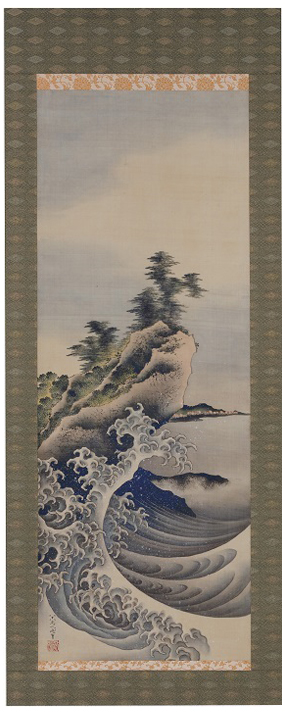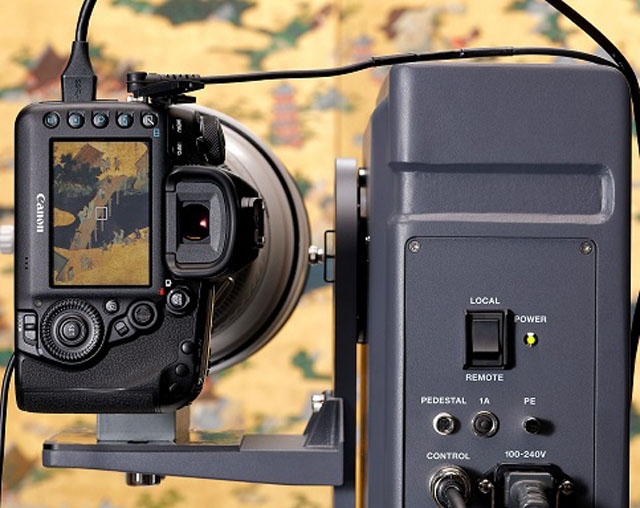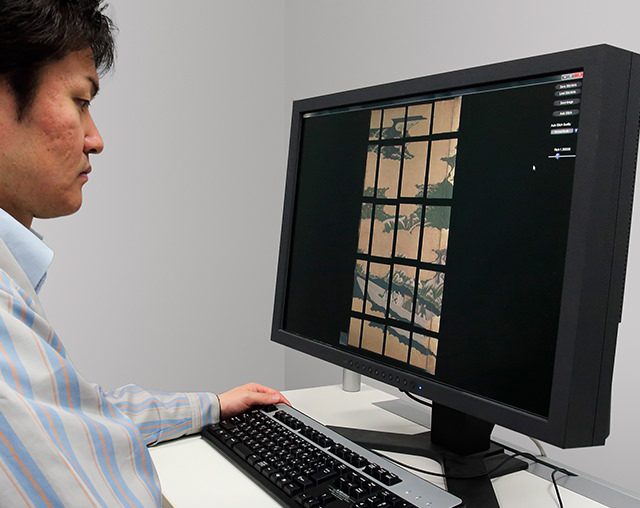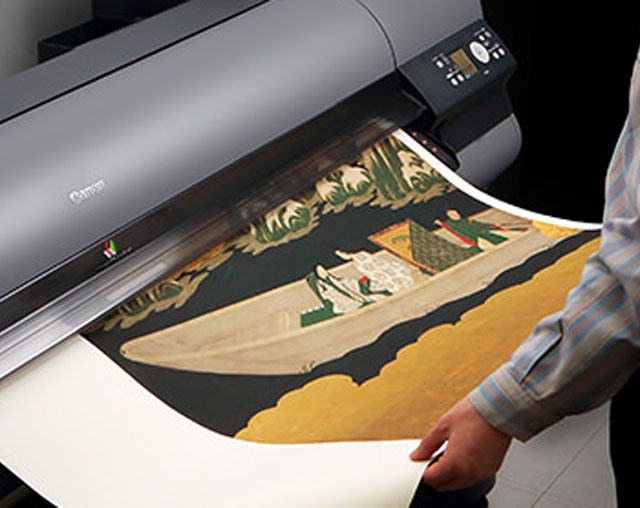News Release

Canon Inc.
Tsuzuri Project to donate high-resolution facsimiles of 13 works by Katsushika Hokusai, in the collection of the Smithsonian Institution Freer Gallery of Art, to Tokyo's Sumida Ward
TOKYO, June 24, 2019—Canon Inc. announced today that the Tsuzuri Project (officially, the Cultural Heritage Inheritance Project), a joint project organized by Canon and the Kyoto Culture Association (NPO), will donate 13 high-resolution facsimiles of works by Katsushika Hokusai—including "Six Tama Rivers" and "Breaking Waves"—the originals of which reside in the collection of the Smithsonian Institution Freer Gallery of Art (Freer Gallery), as part of the project's Stage 12. The facsimiles will be donated to Tokyo's Sumida Ward and on display at the Sumida Hokusai Museum from June 25.

Six Tama Rivers
Six Tama Rivers is a folding screen comprising two halves, each consisting of six panels, based on the six Tama Rivers found throughout Japan described in an old poem. The folding screens on display at the Freer Gallery comprise six portraits of human subjects on the right half, while the left half features six unique landscapes. However, it is considered highly likely that the portraits of the left half are in fact intended to be arranged in pairs with their corresponding landscapes. The high-resolution facsimiles to be donated have been arranged according to newly discovered photographic records and published research related that describe their suggested original layout.
Breaking Waves depicts a tall, claw-shaped wave breaking against a cliff, bearing a close resemblance to the painter's signature "Thirty-six Views of Mount Fuji – The Great Wave off Kanagawa."
Seven of the thirteen high-resolution facsimiles produced have been printed on "kenpon" silk paper developed specifically for this project, while the remaining six are printed on "washi" paper. Not only the colors, but also the texture of the kenpon material have been faithfully recreated according to the original work.

Breaking Waves
Each of the 13 original works currently reside in the collection of the Freer Gallery, located in Washington D.C. The gallery was established in 1923 by American businessman Charles Lang Freer, who explicitly stated in his will that none of the works in the gallery's collection were ever to leave the premises. As such, the only way to view these works thus far has been to visit the gallery in person. Of the 12,700 pieces of Japanese art in the Freer Gallery's collection, the Tsuzuri Project has chosen to produce high-resolution facsimiles of these 13 works by Hokusai and donate them to Tokyo's Sumida Ward—where Hokusai spent much of his life—allowing these famed works of Japanese art to make a symbolic return home.
The 13 high-resolution facsimiles to be donated will go on display from June 25 to August 25, 2019, in an exhibition entitled "The Tsuzuri Project: The Art of Hokusai, reproduced from the collection of the Freer Gallery of Art, Smithsonian Institution." The exhibition is part of the hosting and joint-planning project by the Japan Cultural Expo (Nihonhaku) and the first such project to involve museums on the regional level.
The 13 Works Produced for Stage 12
| Title | Format | Artist | Historical era | Recipient of facsimile |
|---|---|---|---|---|
| Six Tama Rivers | Pair of six-fold screens | Katsushika Hokusai | Edo Period | Sumida Ward |
| A Shinto Priest, Three Women and a Child | Two-fold screens | Katsushika Hokusai | Edo Period | Sumida Ward |
| Country Scenes and Mount Fuji | Pair of six-fold screens | Katsushika Hokusai | Edo Period | Sumida Ward |
| Birds, Animals, and Plants Representing the Twelve Months | Pair of six-fold screens | Katsushika Hokusai | Edo Period | Sumida Ward |
| Thunder god | One scroll | Katsushika Hokusai | Edo Period | Sumida Ward |
| Portrait of a Courtesan Walking | One scroll | Katsushika Hokusai | Edo Period | Sumida Ward |
| Courtesan | One scroll | Katsushika Hokusai | Edo Period | Sumida Ward |
| Breaking Waves | One scroll | Katsushika Hokusai | Edo Period | Sumida Ward |
| Early Ferns, Chapter 48 of The Tale of Genji | One scroll | Katsushika Hokusai | Edo Period | Sumida Ward |
| New Year Custom: Wish for a New Year's Auspicious Dream | Two scrolls | Katsushika Hokusai | Edo Period | Sumida Ward |
| Fisherman | Two scrolls | Katsushika Hokusai | Edo Period | Sumida Ward |
| Crustaceans | One scroll | Katsushika Hokusai | Edo Period | Sumida Ward |
| The Lute and White Snake of Benten (Sarasvati) | One scroll | Katsushika Hokusai | Edo Period | Sumida Ward |
About the Tsuzuri Project
The Tsuzuri Project is a social contribution initiative organized by the Kyoto Culture Association and co-sponsored and promoted by Canon with the goal of preserving original cultural assets and creating high-resolution facsimiles. Combining Canon's technical expertise in imaging, processing and output with the master craftsmanship of traditional Kyoto artisans, the Project produces and donates high-resolution facsimiles of such celebrated historical Japanese cultural assets as folding screens, sliding doors and illustrated scrolls. As of the Project's Stage 11, the camera and lens equipment used in the process of creating the high-resolution facsimiles have been upgraded*.
The Project began in 2007 with two objectives—to donate high-resolution facsimiles of Japanese art abroad to their original owners, and to create high-resolution facsimiles of historical cultural assets that appear in school textbooks for use as tangible educational materials to teach primary and secondary school students about Japan's history, art and culture. Different works have been selected every year since, with the 13 works by Hokusai most recently donated as the Project's 39th through 51st facsimiles.
For more information, please visit the official Tsuzuri Project website.
- *As of Stage 11, the Project utilizes a Canon EOS 5D Mark IV digital SLR camera and EF 400mm f/2.8L IS II USM lens. As of Stage 12, the Project utilizes an imagePROGRAF PRO-4000 large-format printer.
Input |
Capturing high-resolution digital dataA digital SLR camera is used to capture high-image-quality data for output in the actual size and dimensions of the original cultural artifact. The camera is mounted on a specially designed turntable, enabling it to capture segmented portions of the original work, which are then digitally stitched into a single high-resolution image file. |
Color matching |
Highly accurate color matching systemThe high-resolution data is digitally processed using Canon's proprietary color matching system, which corrects for inherent differences in the lighting environment where the work was photographed. The image is printed and colors are matched on location, helping to minimize both technicians' workload and the wear on the original cultural artifact. |
Output |
World's highest level of printing technologyJapanese art expresses a dimensional depth through its delicate tonal subtleties and shading. These are recreated using Canon's imagePROGRAF large-format inkjet printer, which outputs the data onto washi or silk paper that we have specially designed to be ideally suited for printing facsimiles of the cultural artifacts and applying such finishes as gold leaf. |
Gold leaf, gold paint & isinglass |
Reproduced through time-honored and traditional techniquesAuthentic Kyoto Nishijin craftsmen reproduce the most significant features used in Japanese cultural artifacts—gold leaf, gold paint and isinglass. Special "color fading" techniques recreate the effects that time has had on the gold leaf. |
Mounting |
A discipline developed in KyotoA master Kyoto framer carefully mounts the output and finished facsimile using traditional Japanese tools. Great care is taken to recreate fading in the metalwork and fabric used in folding screens, while sliding door panels are installed exactly as they were in their original locations. |
About the Japan Cultural Expo (Nihonhaku)
The Japan Cultural Expo is a large-scale nationwide project that brings together the combined efforts of the Agency for Cultural Affairs, the Japan Arts Council and related government and cultural institutions, as well as such entities as local municipalities and NGOs. With the approach of the Tokyo 2020 Olympic and Paralympic Games, the Japan Cultural Expo is holding various events across the country and throughout the year, including such events as stage performances and cultural festivals that represent the Japanese aesthetic from the prehistoric Jōmon period to the modern era, under the unifying theme of "Nature and the Japanese.""The Art of Hokusai, reproduced from the collection of the Freer Gallery of Art, Smithsonian Institution" is one such exhibition, comprising part of the first stage of the Japan Cultural Expo's event hosting and joint-planning project.
Note:
When using images of the works in the collection of the Freer Gallery of Art, images of each work must be accompanied by their respective credits as specified below.
Six Tama Rivers
Facsimiles of works in the collection of the Freer Gallery of Art, Smithsonian Institution, Washington DC:
Gift of Charles Lang Freer, F1904.204-205
Breaking Waves
Facsimiles of works in the collection of the Freer Gallery of Art, Smithsonian Institution, Washington DC:
Gift of Charles Lang Freer, F1905.276
